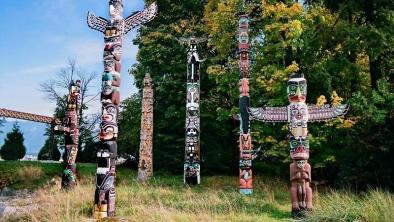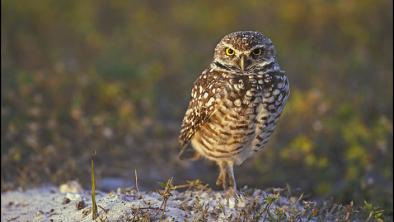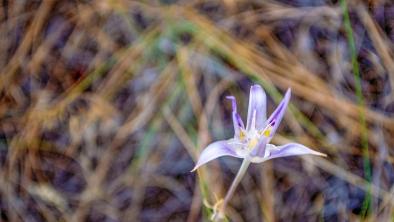Battle to create Grasslands park pits ecologists against ranchers
Friday, August 22, 2014
Globe and Mail
Greg Byron stops his van, and the dust it has been kicking up during the ascent of Kruger Mountain momentarily hangs in the air. The area’s famous grasslands have given way to a growing forest of ponderosa pines, their branches the takeoff and landing site for Brewer’s sparrows and pygmy nuthatches and any number of species of birds that will spend the day scouring creases in the bark for insects.
Mr. Byron gathers his guests beside the edge of a mountain lake and points to a cluster of lily pads and a tangle of marsh reeds. “Do you see him?” he asks. Eventually a less discerning eye picks up the olive shell and the red, orange and yellow stripes of his neck. “That is your painted turtle,” says Mr. Byron, owner of Great Horned Owl Eco Tours. “Isn’t it beautiful? Isn’t all this beautiful? Why you wouldn’t want to preserve this as a national park is simply beyond me. This is one of the most special and important places in the entire world.”
The tour operator has brought us to the eastern edges of the proposed Grasslands National Park, a 286-square-kilometre tract of land in the south Okanagan that is home to more endangered species than any other region in the country. The project has been the source of controversy almost from its inception, with hunters and some area ranchers opposed to any infringement on their daily pleasures and way of life.
A couple of years ago, the B.C. government broke off talks with the federal government on the park’s future, saying there was not enough consensus in the south Okanagan to continue having discussions. But now a new, pro-park coalition is attempting to pressure Victoria to get back to the table and at least hear Parks Canada out on the benefits associated with its proposal.
The group’s call comes amid heightening concerns that the integrity of the country’s parks system is under threat as a result of budget cuts and fresh pressure being applied by resource-based industries to open up more land to exploration. In a recent report, the Canada Parks and Wilderness Society pointed to changes made this year to the B.C. Parks Act as being particularly grievous. Those amendments allow industrial research in parks and make it easier to alter park boundaries to accommodate pipelines and other developments.
The latest offensive by Grassland park proponents is being led by some of the south Okanagan’s most prominent citizens. And their bid to get the park plan back on track has put them distinctly at odds with the region’s provincial political representative, Liberal MLA Linda Larson, who is firmly against the idea. Her position has led some to suggest she is simply repaying wealthy ranchers and others who financially supported her election campaign and who want nothing to do with a national park. The result is a fraught political and social environment that has seen tempers on either side of the debate sometimes get as hot as the summer weather here.
The dispute centres around land in the southern end of the Okanagan Valley that was created some 180 million years ago by a series of continental collisions. This was followed by a period of intense volcanic activity. Then the Ice Age arrived and the valley became a huge glacier. It eventually retreated, leaving the valley in the state one finds it today. But its history helps explain the rich topography of the valley, now one of the best wine-growing regions in North America.
Part of that landscape includes the desert grasslands that truly characterize the south Okanagan and set it apart from other valleys in the country. The area is home to a unique and thriving eco-system that boasts some of the rarest plant and animal species found anywhere on Earth. It is for this reason that Parks Canada wants to offer protection from future development by giving the area national park designation.
“There is no other place in Canada like it in terms of its environment and ecology,” says biologist Dick Cannings, who has literally written the book on the subject. “There is no other place in North America with a higher bird diversity rating than the Okanagan. It’s why birders come from all over to see it for themselves.”
There are 56 federally listed endangered species in the proposed park area, including birds, mammals and plants not found in another region of the country. Eleven per cent of all the threatened species in Canada exist here, including the Flammulated Owl and the Great Basin Spadefoot toad. Over 200 species of birds nest in the Okanagan Valley, more than anywhere else in Canada. Fourteen species of bats also call the valley home. There are more than 700 species of wildflowers, 150 different species of butterflies and more than 200 species of grasses in the Okanagan as well.
“The diversity of species is a condition of the diversity of habitat,” Mr. Cannings explains. “You have desert grassland and valley floor, you have big lakes, rivers and marshes, you have ponderosa pine forests and Douglas fir and spruce forest and alpine parkland and alpine tundra. So there is a tremendous diversity in environment within a few kilometres of where they want to create this park. It’s like no other place in that regard.”
Parks Canada first rolled out its proposal in 2006, a design that called for more than 600 square kilometres to be protected. That meant hunting and fishing would be banned in the area, as well as any commercial enterprises. Under park guidelines, ranching would be prohibited too. The early response to the proposal was negative, especially with cattle ranchers and hunters. Soon, large NO PARK signs began popping up along major roadways in the area. The few Yes signs that were erected were quickly vandalized, some even marred by bullet holes.
This made Parks Canada step back and reconsider its idea. It came back with a new plan less than half the previous size, cutting out an area that was popular with hunters. It also decided to allow existing ranching to continue in perpetuity, but also made clear that any rancher who did want to sell would have, in Parks Canada, a willing buyer at market prices. It also said it was prepared to grandfather the one existing business inside the park, a helicopter company. In other words, the federal government was prepared to give opponents of the park almost everything they wanted.
Doreen Olson, a long-time national park supporter and director of the South Okanagan Similkameen National Park Network, is one of many local residents worried that if ironclad protections aren’t put in place, this vital area of the valley will eventually be developed like so many other parts of the region.
“I was in a coffee shop and heard a couple of developers talking about the park and they were saying, ‘It’s just a bunch of scrub land of no real value,’” Ms. Olson recalls of the moment when she realized that people didn’t appreciate what they had here. “We don’t have the mega-fauna that makes a park look attractive. People love to see elk and other flashy animals. We don’t have that and most of the species that are endangered are small ugly things like rattlesnakes and bats and crickets. But all those things are important to the grasslands.”
Ms. Olson said many people who support the idea of a park are afraid to speak out because they feel intimidated. “Mostly it’s the old guard in the area who are opposed to it, and they are generally high-profile in the community and people are afraid to speak up against them. But there is a tremendous amount of silent support for this project, I know it.”
Jim Wyse, founder of the Burrowing Owl winery in Oliver, concedes the park proposal got off to a rocky start. But now, he believes, it is gaining traction with residents as they learn more about what is actually being proposed – as opposed to what critics are suggesting will occur.
“We need to get the province back at the table,” said Mr. Wyse, who for a number of years has led a conservation effort to bring back to the region the owl for which his winery is named. “I don’t think there has been nearly the recognition of the major compromises Parks Canada has made here. This park should be an absolute no-brainer, one that would be a boon for tourism in the area. It’s madness that we’ve just walked away from this opportunity. Other areas would kill for something like this in their backyard.”
Holly Plante, past president of the South Okanagan Chamber of Commerce, said studies have been done that show the park would have a significant economic impact. A resolution passed at the recent B.C. Chamber of Commerce annual general meeting said a national park would support 570 full-time equivalent jobs, generate more than $37-million in gross domestic product, $25-million in annual labour income and $49-million in visitor spending annually. The motion called on the B.C. government to re-engage in talks with Parks Canada.
“There is a real solid business case for this park, which I think this provincial government really needs to consider here,” Ms. Plante says.
So far, park advocates have been unable to sway the Liberals’ Ms. Larson. Speaking on behalf of all the dissenters, Ms. Larson says she can’t understand why those who want the park insist on “flogging a dead horse.” She dismisses studies that say the park would be an economic generator, saying you can get a study to say anything you want.
She also rejects the numbers associated with the project as “hype” and said no one talks about the economic opportunities that would be squandered if the area was turned into a park – like mining. She said a national park would completely block any chance companies had of exploring their claims, suggesting the Liberals are open to the idea of seeing this area mined.
“Whether the pro-park people want to believe it or not,” Ms. Larson said in an interview. “There are as many or more non-pro people on the other side of this debate.”
Ms. Larson believes there are other ways to protect the integrity of the park, without putting it under the restrictions a National Park designation would impose. She said a resource management plan for the area that was sketched out eight years ago would offer protections without infringing on others’ ability to use the area to make a living.
For Mr. Wyse and others, the park is worth continuing to fight for. It would offer the greatest degree of protection, and a national park designation would bring in tourists from around the world, he says. He recently led a delegation that met with Environment Minister Mary Polak for nearly an hour. “She didn’t kick us out so that’s a good thing,” he says. There could be further meetings down the road.
Meantime, Greg Byron, who spends several days a week traversing the roads and trails that the proposed national park would encompass, has trouble contemplating all the fuss.
“This is a very fragile ecosystem with all of these endangered species who make their home up there and the area is being degraded by the day because of the ATVs [all-terrain vehicles] running around up there, and the cattle grazing and lots of stuff,” he says. “If we don’t do something to protect this area we’ll see some species disappear from the landscape altogether.”
Mr. Byron shakes his head.
“I don’t think people understand what they have here. This is special, really special. This is a one-time-only shot, I think. And if we don’t do it, shame on us for letting it slip away.”
Photo: Doreen Olsen stands in the South Okanagan Grasslands Protected Area Blue bunch wheatgrass near Osoyoos, B.C. August 21, 2014. Olsen would like to see the area made into a National Park


